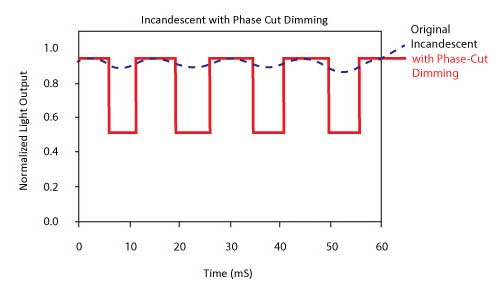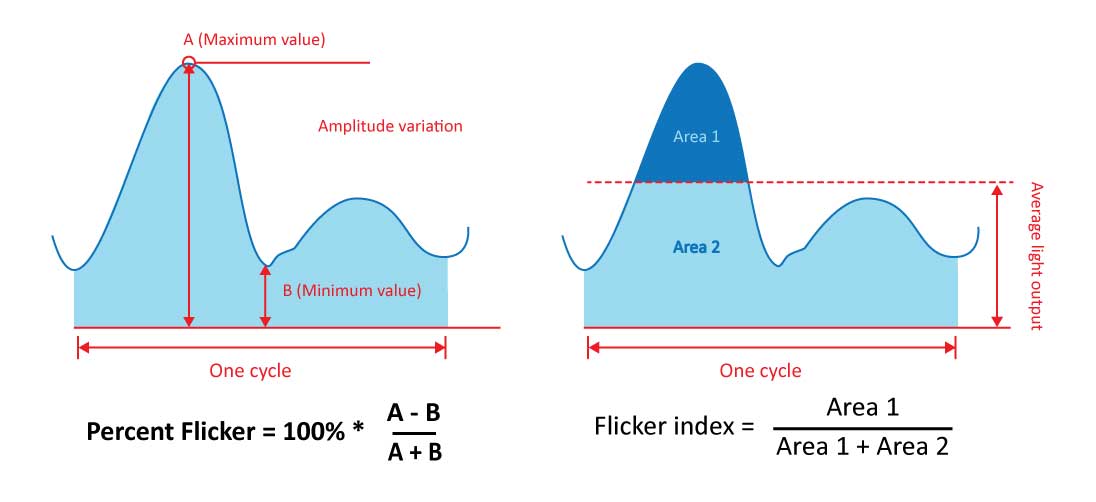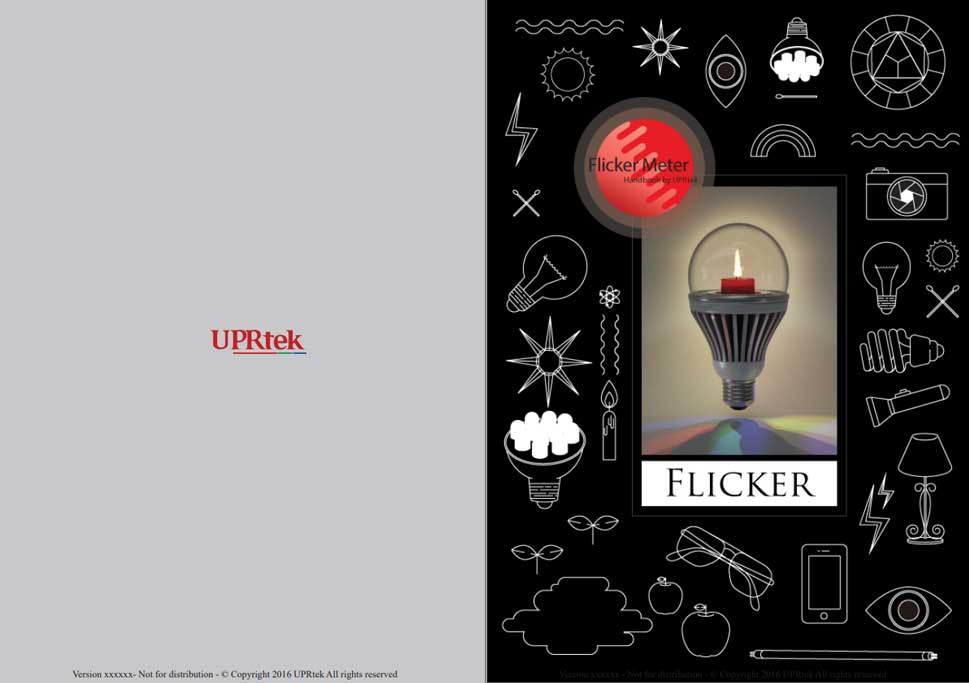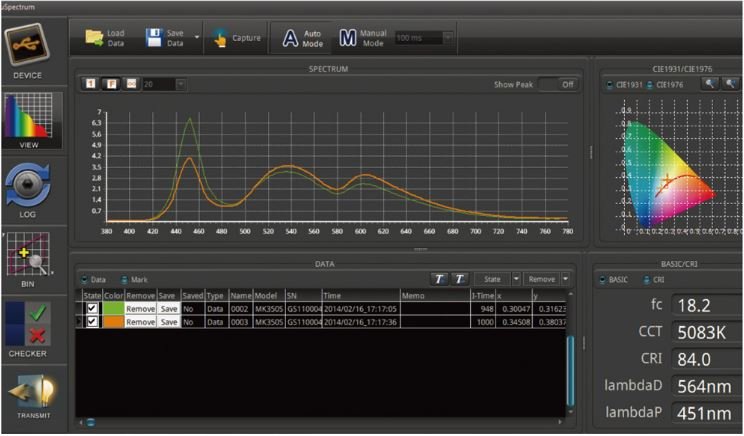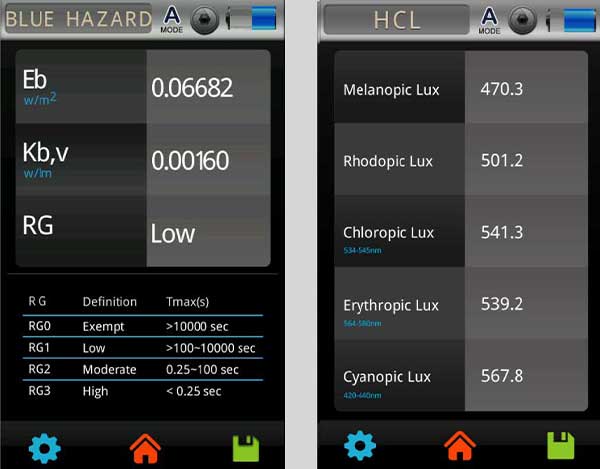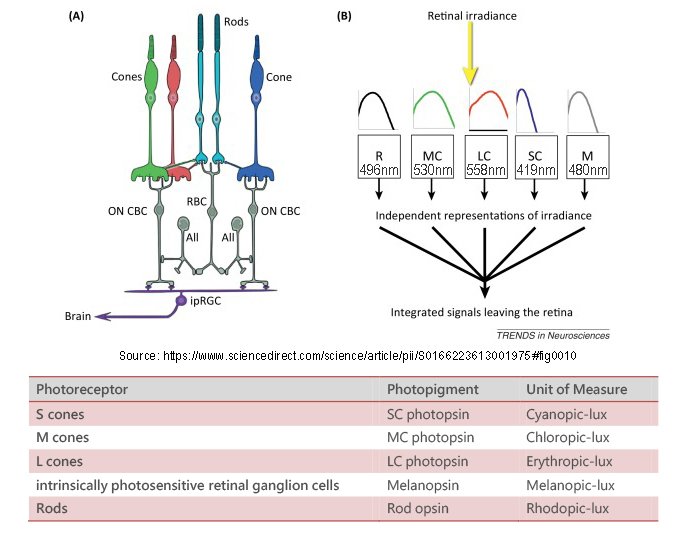Light and Visual Safety
Flicker, Blue Light Hazard and Human Centric Lighting
Every product has consequences to safety and health, and an artificial light is no different. Worldwide standards organizations and government agencies have taken notice and are implementing regulations. Here we explore some of the visual safety challenges regarding artificial lighting and some of the things we can do to mitigate those situations.

MK350S Premium Spectrometer
Light Safety
Ever since Fluorescent Lights, we’ve become cautious about the negative effects of artificial lighting. Early fluorescent lights exhibited flicker, which had been implicated in a host of health related issues. Now, with the advent of LED lighting, old and new problems are once again emerging and we must ramp up our efforts to deal with these issues.
- Flicker
- Blue Light Hazard
- HCL(Human Centric Lighting)
What is Flicker?
Flicker is where a light exhibits a subtle pulsating or strobing effect, hardly noticeable by the human eye. And yet, it has been implicated in a host of issues, which include migraines, fatigue and even epileptic seizures. It has even been blamed for diminished work productivity and visual impairment around dangerous equipment.
All lights have the potential to flicker because of the electricity from the power mains, which produces AC or Alternating Current. Modern fluorescent lights have more or less resolved this problem with a technology called an electronic ballast.
With the advent of LED lights, we saw a revival of flicker. So LED manufacturers developed what is called a “driver” which mitigates flicker. But not all lights are created equal and neither are their drivers, and so you can still experience LED lights with flicker.
Another aspect of flicker is “dimming”. When you dim a light, it is placing cuts (Phase Cuts) into the light wave, essentially “cutting” out parts of the light to make it dimmer. Even though you can’t see the “cuts”, they are reintroducing the specter of flicker.
How do you check for Flicker?
The best way to measure flicker is to get a flicker meter with flicker metrics. Flicker metrics include Percent Flicker and Flicker Index. The Percent Flicker was the first metric ever, and it measured the proportional difference between the wave trough and max height of the wave (vertical aspect). But it didn’t take into account the height and width of the wave (i.e. area) that is also a factor in flicker – and so was born the Flicker Index that does take into account height and width.
Basically, the higher values for both of these metrics tends to favor higher flicker severity.
The amount of flicker indicated by metrics also needs to be evaluated. IEEE PAR 1789-2015 provides guidelines suggesting the severity of flicker metrices. Products like the MK350S Premium incorporate these guidelines and produces a graphic to show the severity of the flicker (see below graphic, far right).
Stroboscopic Effects and SVM
Stroboscopic effect can be seen as the “wagon wheel” effect in movies, where the spokes of a wheel on a moving wagon seem to slow down, stop and even rotate counterclockwise. This can also be seen in helicopter blades.
Stroboscopic effect also applies to light flicker. We can use an example of a flickering light shining on a power saw. When the speed of the rotating teeth on the spinning blade syncs with the flickering rate of the light, it can appear that the blades are not spinning, when actually, they are at dangerous speeds. As you can imagine, this could be catastrophic in a factory environment with many workers doing their tasks in and around the saw.
There is a metric called SVM that measures Stroboscopic Effect. It is provided by UPRtek products that support flicker measurement. As SVM increases the severity or visibility of Stroboscopics Effect increases.
What is Blue Light Hazard?
You’ve probably heard of Blue Light. Blue light is more detrimental for your eyes than red light, which may seem counterintuitive because you normally associate blue with “cool” and red with “hot”. However, blue light has a shorter wavelength and that comes with higher energy. And so the term High Energy Visible (HEV) light has been applied to hazardous amounts of blue light. HEV light has been implicated in visual pathologies such as cataracts and macular degeneration.
The Sun emits a lot of blue light, as does LED lighting and flat-screen monitors. The distance and exposure time to the blue light are also important factors. And of course there are products on the market that alleviate HEV hazards such as anti-blue-light glasses or anti-blue-screen covers for monitors.
The following is the uSpectrum screen of the MK350S Premium spectrometer. The screen uses the Comparison Mode to test two different settings “cool” and “warm” mode on the display panel. Note that Blue portion of the Spectrum has dropped significantly
How do you measure Blue Light Hazard (BLH)?
A spectrometer with Blue Light Hazard metrics can provide lighting information about HEV. There are guidelines for HEV safety, notably EIC 62778 and IEC 62471. The MK350S Premium uses them to measure and evaluate HEV severity.
MK350S Premium Blue Light Hazard data (left) – The RG values stands for “Risk Group”.
Eb, Kbv are BLH (blue light hazard) metrics used by researchers to gauge the photometric quantities of blue light that present a photobiological hazard. They are used to derive a “Risk Group” evaluation.
LEDs are everywhere and we are unknowingly exposed to high intensity blue light everday; at stage concerts, sitting in a dentist’s chair or even driving at night with bright LED road lights. How much is too much, and is it insidiously doing retinal damage over time. This is where standards organizations, HEV metrics and spectral measuring devices are important tools for combatting hazardous blue light.
Resources:
https://www.ledsmagazine.com/smart-lighting-iot/smart-cities/article/16695906/risk-group-determination-characterizes-photobiological-safety-in-led-lighting-magazine
https://www.researchgate.net/publication/282437539_Blue_Light_Hazard_and_Risk_Group_Classification_of_8_W_LED_Tubes_Replacing_Fluorescent_Tubes_through_Optical_Radiation_Measurements
https://www.energex.com.au/__data/assets/pdf_file/0004/757174/Blue-light-hazards-report-March-2019.pdf
What is HCL (Human Centric Lighting)?
In recent years, there has been increasing attention to how sunlight can influence our behavior. Humans have, through millions years of evolution, become physiologically attached to the colors of sunlight as it rises and sets everyday. But with the advent of artificial lighting, studies show these color patterns are being distrupted, causing behavioral problems such as insomnia and fatigue.
We used to think that the Rods and Cones were the only types of photoreceptors (light reactive components) in our visual system. Now a third type of photoreceptor had been found.
This photoreceptor, called ipRGC, is an evolutionary feature, which is sensitive to sunlight colors as they change throughout the day.
As the sun rises, the cooler blue light causes the ipRGC receptors to kickoff mechanisms to shut down the hormones for rest/sleep (i.e. melatonin), and encourage the wake-up hormones (i.e. dopamine, cortisol, seratonin). As the sun sets, the colors become a warmer orange/yellow, which encourage melatonin secretion for rest and sleep.

“At the beginning of this millennium, a third type of photoreceptors, the intrinsically photosensitive retinal ganglion cells (ipRGCs), in the eye was discovered.”

Disruption of our Circadian Rhythms
When these circadian patterns are disrupted, so is our natural routine of wake and sleep. With the advent of artificial lights, afternoon/evening blue light from overhead lights, cell phones and display panels can errantly trigger a wake-up-call, when we should be preparing for rest and eventually sleep. These disruptions can cause insomnia, fatigue and general malaise, not too mention a host of other hormonal related disorders.
HCL or Human Centric Lighting makes sure lighting is conducive to our natural circadian patterns. In effect, the goal of artificial HCL lighting is to mimic the colors of the Sun throughout the day.
Measuring HCL
There are metrics to measure HCL, as derived from the WELL Building Standard (V1) and CIE TN 003-2015. The image below shows the MK350S Premium Blue Light and HCL metrics.
The metrics for HCL (top right), represent the quantities of light for certain wavelengths associated with a certain photopigment in the retina (see below). As the light is absorbed by a photopigment, it produces physiological change in our bodies. The most well known is the “Melanopic Lux” , which represents the photometric quantities of light at 480nm, that will affect melanopsin, known for regulating our circadian cycles.
HCL is an exciting advancement in lighting and physiology. We have discovered that light can adversely affect our hormonal and behavioral activities. Conversely, it is a new opportunity to use this newfound knowledge to our advantage. And that is using light as a form of therapy. And this requires proper spectral evaluation and quantitative light measurement.
For more read “Measuring and using light in the melanopsin age”, Trends in Neurosciences
Healthy, Safe Lighting.
Lighting is not without safety issues, and can cause a host of problems over time including visual degradation and behavioral problems. Lighting organizations and even government agencies are combatting these issues with regulations and guidelines. Light measuring devices are used to help take the risk out of obtaining lights that are unsafe for use with accurate evaluation and assessment.
Handbook Series
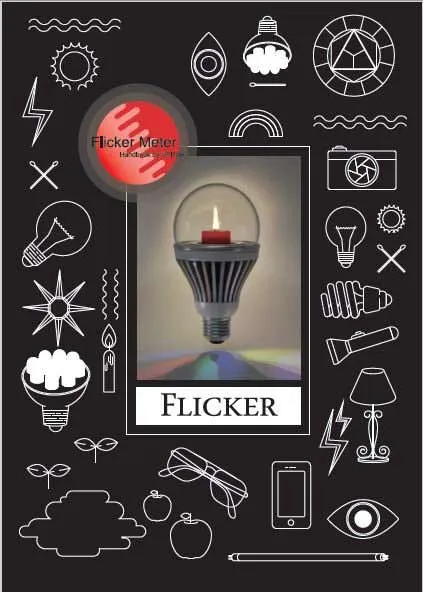
The Flicker Handbook
Everything thing you need to know about Flicker, an insidious, potentially serious lighting artifact impacting visual safety for public places like hospitals, offices, libraries, and more...
About UPRtek

United Power Research and Technology
UPRtek (est. 2010) is a manufacturer of portable, high-precision light measurement instruments; Handheld Spectrometers, PAR meters, Spectroradiometers, Light Calibration Solutions.
UPRtek HQ, R&D and manufacturing are all based out of Taiwan, with Worldwide representation through our certified Global Resellers.
Latest Articles
Category

